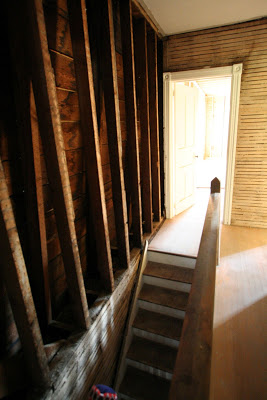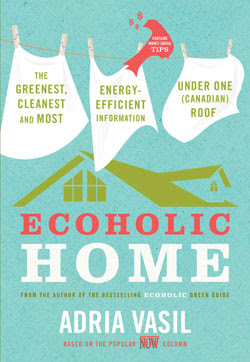In lieu of Earth Day, let’s talk eco-friendly renovaton. It’s not easy. Intentions are usually set high, at least mine were. I intended to save and reuse much of the material left from my demolition but I was quickly shut down. I was told it was useless and for the most part, too much work to reuse. Yes, I was disappointed but during the process, it did seem best to get rid of the waste versus storing it on my small site. If you have a stronger backbone than I, kudos to you. Perhaps you can assist me in my next project.
 |
| After the kitchen demolition. |
I like to consider myself an eco-friendly individual but sadly, I somewhat failed during this renovation process. Without being hard on myself, I was able to restore much of the old character in the original house such as the baseboards, doors , fireplace and flooring. And I also did make some serious improvements on my home’s carbon foot print. Want to know how to decrease your carbon footprint and pull off an eco-friendly reno? Use the following as a guideline to help educate some of your choices during the hectic, stressful time of renovating.
- Insulate: In my old, double brick home, insulation did not exist. To improve on heating bills and energy waste, I insulated the house with the highest R rating possible. An R rating measures the value that insulation can resist heat flow. The higher rating, the better. Consult with your contractor on the best R rating for your home.
 |
| Upper Hall way had no insulation. I could touch the backside of the roof! |
- Replace The Old. Generally, old windows and doors should be replaced if you hope to hold in your heat during the winter months. If you are experiencing a “draft”, this is likely due to the seal on your doors and windows. Replacing these are tough on the pocket book, but will save you oodles of money on your heating bills and in turn, will lower your carbon footprint.
- Reduce, Reuse, Recycle. As the old saying goes, it holds true for your household and renovation waste. Although reusing old materials may be difficult, donating major items such as old doors, windows and cabinetry would help reduce waste. Call around your local area to find a dealer that takes old house materials. Habitat for Humanity Restore is a perfect example of organizations that will come onsite and claim your materials, provided they are in decent shape.
- Do Some Research. Before starting your project, look into local services that can help guide you to a greener renovation. The book, Echolic Home by Adria Vasil is a fantastic resource that provides user friendly solutions on how to not only source green products and materials, but also various organizations that support eco conscious home improvements. Need some other informative sites to check out? Try these… Building Green, Green Builder Advisor and Ecologo Program.
- Get Paid in Rebates. Depending where you live, rebate incentives are another great reason to consider improving your home’s carbon footprint. Check out programs such as Energy Star and ecoENERGY to get more information on how to get paid to go green!
- Go Retro! In today’s era of Craigslist and Kijiji, it is easy to find, buy and sell furniture, equipment and appliances. I bought high end laundry machines for a third of the cost from Kijiji only because they were used. Restoring old furniture is not only affordable, but also custom and interesting!
 |
| Take an Old Ottoman… |
 |
| …and turn it into something great! |
Of course, I have just scrapped the surface of this environmental issue, but these guidelines will help educate your renovation choices and further decisions in your home. Going green is a reality for all of us, so let’s start to make changes, big or small in our homes. For Sunday’s events, check out your local listings to see what is happening in your community!
Happy Earth Day!
